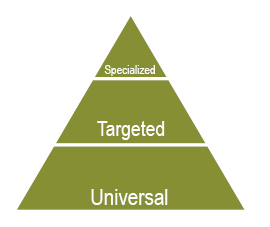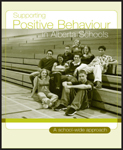
|
Universal Supports benefit all students
- Work collaboratively with school staff to ensure that all extracurricular activities are organized to maximize student engagement and participation, and:
- have clear goals and purposes
- offer structures and activities that are meaningful to students
- are accessible by all students, including students with disabilities.
- Develop a survey or other information-gathering strategy to identify the
extracurricular interests and needs of students throughout the school and develop a school-wide plan for developing and supporting activities that will engage and benefit a wide range of students.
- Choose activities thoughtfully to ensure all activities are inclusive and all students can participate and be successful. As participation in extracurricular activities is positively linked with successful school completion, consider the needs and interests of students who may be at-risk for early school leaving
and/or who would not typically participate in extracurricular activities.
- Collaborate with adult supervisors of activities to develop effective routines that support positive behaviour and participation during activities, such as:
- previewing of goals and program schedule with students prior to activities
- planning for active supervision.
- Work with adult supervisors of activities to ensure that clear expectations about behaviour and participation during extracurricular activities are communicated to students. At the beginning of each activity, build in time to teach, practise and review rules and safety guidelines for the activity.
- Plan for extra supervision needed, such as parent or community volunteers or buddies from another grade. Assign clear roles and responsibilities to volunteers and provide them with activity schedules, behaviour expectations and tips for supporting individual students.
- Post visual reminders for
behaviour expectations in the learning space where activities
will take place and review reminders before the event. When
appropriate, collaborate with students to develop these visual
reminders.
- Use descriptive feedback to acknowledge positive behaviour demonstrated by individuals and/or groups of students during extracurricular activities.
|
|

|
Targeted Supports benefit students with more specific needs
- Pair individual students with positive peers who can serve as role models and provide support during extracurricular activities. Rotate these peers at regular intervals throughout the school year.
- Provide proximity by positioning yourself (or a volunteer supervisor) nearby individual students who may require support during activities.
- For students who require more structure and reassurance, develop and review social stories about what will happen in an extracurricular activity.
- Complete an environmental scan on the activity and identify specific skills that are essential for successful participation (e.g., taking turns, how to be a good sport, putting away equipment). Work with small groups or with individual students and directly teach social skills related to that activity.
- Work with individual students and extracurricular supervisors to develop low-key cues and prompts that supervisors can use to remind students to use coping strategies, such as positive self-talk, taking a deep breath or counting to 10 when frustrated.
- Provide personalized visual checklists that students can carry with them as a reference and friendly reminder for following routines or using strategies such as positive self-talk.
- Develop self-monitoring strategies students can use to keep track of their own behaviour and active participation during extracurricular activities.
|
Parents know their children well and can offer insights on how to support
their social and emotional well-being. There is strength in collaborating
on strategies that could be used at home, at school and in the community.
|

|
Specialized Supports benefit the small number of students with sensory, physical, cognitive or behavioural needs that require intensive, individualized interventions
- For students with intense sensitivities to sound, explore the use of
sound-muffling ear plugs that would minimize noise (such as loud music or cheering) during activities.
In exceptional cases, an individual student may need 1:1 adult support to facilitate participation in extracurricular activities and social interactions and communication with other students and adults. This support should be provided as unobtrusively as possible.
- In addition, the adult providing this 1:1 should collaborate with the student's learning team to identify and facilitate as many ways as possible to create opportunities, provide strategies, modify activities and adjust and/or fade support so the student can experience some degree of independence throughout the activity.
- Consider limited-time participation for students who experience intense agitation or anxiety during extracurricular activities. They may benefit from participating in the activity for a short time (e.g., five minutes) and then gradually increasing the time throughout the school year.
- If needed, provide coaching for peers on specific strategies for engaging students who requires more support (e.g., how to encourage eye contact, importance of one-step directions using concrete language, using high-fives and handshakes to acknowledge and encourage effort).
|








